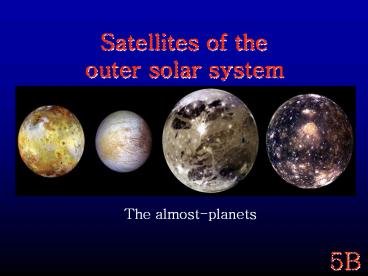Satellites of the outer solar system - PowerPoint PPT Presentation
Title:
Satellites of the outer solar system
Description:
Satellites of the outer solar system The almost-planets – PowerPoint PPT presentation
Number of Views:164
Avg rating:3.0/5.0
Title: Satellites of the outer solar system
1
Satellites of the outer solar system
- The almost-planets
2
Large Moons
3
Galilean Satellites
4
Interiors
5
Surfaces
6
Io
7
Io Glowing in the Dark...
- Galileo images show glowing gases, hot volcanos,
in Jupiters shadow - Volcanic glow suggests volcanos are too hot to be
ordinary basalt magma
8
Eruptions
9
(No Transcript)
10
Europa
11
100 x 140 km
12
32 x 42 km
13
1.7 x 4 km
- Eroded appearance at highest resolution Few
impact craters
14
Ganymede
15
Voyager 2 terrain types on Ganymede cratered
and grooved
16
79 x 57 km
- Intense faulting in grooved terrain
17
- But some young areas are very smooth
- Surface age 3.5 b.y. or 1.0 b.y.?
54 x 90 km
18
- Cratered terrain also complex
19
Callisto
- Multi-ring basins
- Bright fresh craters
- Many, many, other craters.
1400 km across
20
- Zooming in on Callisto
21
- Big surprise at high resolution
- Eroded appearance
- Few small craters
55 x 44 km
22
- Dark material between craters is very smooth at
small scales- - Why? Sublimation?
13 x 13 km
23
Comparative planetology
24
Surface Processes
- Io
- Volcanism (endogenic)
- No craters (young surface)
- Europa
- Tectonics (endogenic)
- Cryovolcanism (endogenic)
- Few craters (young surface)
- Ganymede
- Tectonics (endogenic)
- Some craters (older surface)
- Callisto
- Mostly Craters (very old surface)
25
Energy
- Recall, for endogenic processes to occur energy
is needed. - However, the Galilean satellites are small, so
they have little internal heat (original or
radioactive). They are far from the Sun, so get
little solar energy. Where does the energy come
from?
26
Tidal Heating
27
Titan
28
Titan
- Titans surface will be revealed with radar
mapping by the Cassini spacecraft - Its atmosphere will be measured with the Huygens
probe - Its thick atmosphere harbors complex chemical
reactions - For this reason, it is interesting to study as an
early-earth analog and it may harbor life - The surface may consist of large ethane seas
29
Triton
30
Triton
- Triton is in a retrograde motion. This implies
it was captured. Combine this fact with their
compositional similarities and Plutos uniqueness
leads some to postulate a similar origin for the
two bodies. - The existence of an atmosphere on Triton can be
seen in the wind streaks on the surface - Tritons surface is relatively young, there are
few craters.
31
(No Transcript)
32
Prometheus
Thalassa
Larissa
Janus
Proteus
Despina
33
Small Satellites
- The remaining outer planet satellites are small
bodies of rock and ice - They have little internal heating and little
endogenic activity - Because of their old surfaces, they are generally
heavily cratered
34
Small Satellites some are quirky
- Mimass large crater Hershel was almost enough to
shatter the small moon - Iapetus is two-faced with a dark leading
hemisphere (3 reflectivity) and a bright
trailing hemisphere (50) - Mirandas surface is extensively modified with
great valley systems (10 km deep) and peculiar
trapezoidal mountain ranges
35
Comparative Planetology 2
- In general, the bigger a planetary body is, the
more energy is available to modify it - Small bodies are irregularly shaped and covered
only with craters (exogenic) - Slightly bigger bodies are spherical
- Bigger bodies are spherical and differentiated
- The largest bodies are spherical, differentiated,
and have endogenic processes which modify their
surfaces































